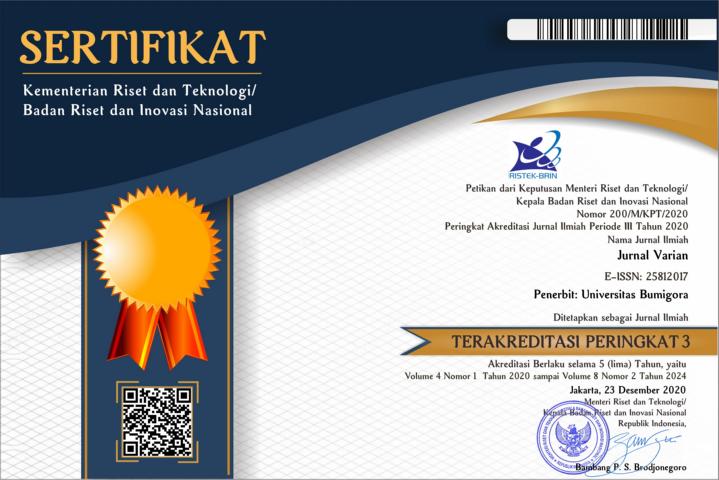Expansion of Stock Portfolio Risk Analysis Using Hybrid Monte Carlo-Expected Tail Loss
Abstract
Monte Carlo-Expected Tail Loss (MC-ETL) is the new expansion method that combines simulation and calculation to measure investment risk. This study models US stock prices using ARIMA-GARCH and forms an optimized portfolio based on Multi-Objective that aims to analyze the portfolio investment return. The next portfolio return will be simulated using the Monte Carlo (MC) method, measured based on the Expected Tail Loss (ETL) calculation. The optimized portfolio comprises 5 US stocks from 10 years of data, with the biggest capitalization market on February 25, 2021. MSFT has the most considerable weight in the optimized portfolio, followed by GOOG, AAPL, and AMZN, whereas TSLA shares have negligible weight. Based on the simulation result, the optimized portfolio has the smallest ETL value compared to its constituent stocks, which is ±0.029 or about 2.9%. This value means that the optimized portfolio is concluded as an investment choice for investors with a low level of risk.
References
Moroccan All Shares Index Portfolio. Mathematics, 6(3):38.
Arif, U. and Sohail, M. T. (2020). Asset Pricing With Higher Co-Moments and CVaR: Evidence from Pakistan Stock Exchange.
International Journal of Economics and Financial Issues, 10(5):243.
Azmi, U. and Syaifudin, W. H. (2020). Peramalan Harga Komoditas Dengan Menggunakan Metode Arima-Garch. Jurnal Varian,
3(2):113–124.
Bellofatto, A., DHondt, C., and De Winne, R. (2018). Subjective Financial Literacy and Retail Investors Behavior. Journal of
Banking & finance, 92:168–181.
Brandstetter, L. and Lehner, O. M. (2015). Opening the Market for Impact Investments: The Need for Adapted Portfolio Tools.
Entrepreneurship Research Journal, 5(2):87–107.
Chandra, P. (2017). Investment Analysis and Portfolio Management. McGraw-Hill Education.
Feng, W., Wang, Y., and Zhang, Z. (2018). Can Cryptocurrencies Be A Safe Haven: A Tail Risk Perspective Analysis. Applied
Economics, 50(44):4745–4762
Giemza, D. (2021). Ranking of Optimal Stock Portfolios Determined on The Basis of Expected Utility Maximization Criterion.
Journal of Economics and Management, 43(1):154–178.
Jareno, F., Negrut, L., et al. (2016). US Stock Market and Macroeconomic Factors. ˜ Journal of Applied Business Research (JABR),
32(1):325–340.
Kulali, I. (2016). Portfolio Optimization Analysis with Markowitz Quadratic Mean-Variance Model. European Journal of Business
and Management, 8(7):73–79.
Lampio, K. (2018). Optimization of Fin Arrays Cooled by Forced or Natural Convection.
Liang, J. J., Yue, C., and Qu, B.-Y. (2016). Multimodal Multi-Objective Optimization: A Preliminary Study. In 2016 IEEE Congress
on Evolutionary Computation (CEC), pages 2454–2461. IEEE.
Ling, R. F. and Rubinstein, R. Y. (1983). Reviewed Work: Simulation and the Monte Carlo Method. Journal of the American
Statistical Association, 78(382):511–512.
Mayuni, I. A. I. and Suarjaya, G. (2018). Pengaruh ROA, FIRM SIZE, EPS, dan PER tTrhadap Return Saham pada Sektor Manufaktur
di BEI. E-Jurnal Manajemen Unud, 7(8):4063–4093.
Nguyen, S. P. and Huynh, T. L. D. (2019). Portfolio Optimization from a Copulas-GJRGARCH-EVT-CVAR Model: Empirical
Evidence from ASEAN Stock Indexes. Quantitative Finance and Economics, 3(3):562–585.
Salim, D. F. and Rizal, N. A. (2021). Portofolio optimal Beta dan Alpha. Jurnal Riset Akuntansi dan Keuangan, 9(1):181–192.
Siswono, G. O., Saputra, W. H., Pricila, V., and Lina, Y. A. (2021). Application of Holt-Winter and Grey Holt-Winter Model in Risk
Analysis of United States (US) Energy Commodities Futures Using Value at Risk (VaR). In International Conference on Global
Optimization and Its Applications 2021, volume 1, pages 126–126.
Sururi, W., Yahya, I., and Abubakar, E. (2021). Analysis of the Effect of Financial Performance, Company Size on Stock Prices with
Dividend Policy as Moderating Variable in Pharmaceutical Companies Listed on the Indonesia Stock Exchange.
Wardiyah, M. L. (2017). Manajemen pasar uang dan pasar modal.
Zheng, X. and Chen, B. M. (2013). Stock Market Modeling and Forecasting, volume 442. Springer.

This work is licensed under a Creative Commons Attribution 4.0 International License.


















